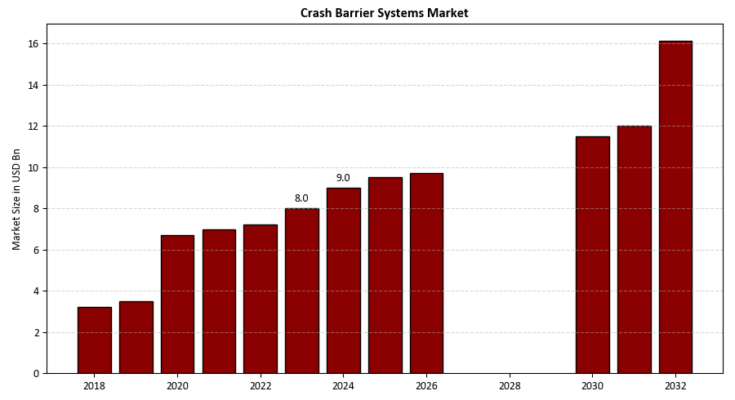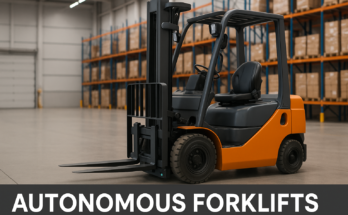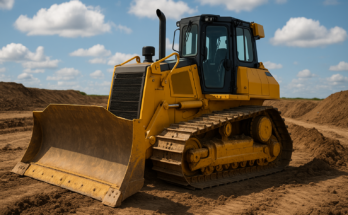Fueled by accelerating infrastructure projects, growing road safety concerns, and technological advancements, the Global Crash Barrier Systems Market Size is projected to witness significant growth, expanding from USD 6.44 billion in 2023 to USD 10.61 billion by 2030, with a CAGR of 7.39% over the forecast period.
Crash Barrier Systems Market Estimation & Definition
Definition
Crash barrier systems are critical safety installations designed to prevent vehicles from leaving roadways, entering dangerous zones, or colliding head-on. These systems are strategically deployed on roads, bridges, highways, pedestrian zones, and construction areas to absorb collision impacts, protect human lives, and minimize structural damage.
Market Size & Forecast
The global market size for crash barrier systems stood at USD 6.44 billion in 2023 and is expected to reach USD 10.61 billion by 2030. This represents a robust 7.39% CAGR between 2024 and 2030, driven by urbanization, motorization, and safety investments across both developed and emerging economies.
Crash Barrier Systems Market Growth Drivers & Opportunities
Key Growth Drivers
-
Heightened Road Safety Awareness: With rising road accident statistics globally, governments and private organizations are prioritizing safety, leading to increased adoption of crash barriers.
-
Infrastructure Expansion: Massive investments in transportation infrastructure—including highways, bridges, and rail corridors—are directly boosting demand for durable crash barrier systems.
-
Stringent Regulatory Frameworks: Mandates for road safety enhancements across multiple countries are accelerating market penetration of crash protection technologies.
-
Technological Advancements: New-generation barrier systems are designed with energy-absorbing materials and smart capabilities, enabling better performance and easier deployment.
Emerging Opportunities
-
Growth in Asia Pacific: Countries like India and China are investing heavily in transport infrastructure, offering significant growth potential for manufacturers and suppliers.
-
Smart Infrastructure Integration: The rising trend of smart cities and intelligent transportation systems opens new avenues for crash barrier technologies with integrated sensors and real-time monitoring.
-
Diversified Use Cases: Beyond road safety, barriers are increasingly being used in stadiums, airports, industrial zones, and military installations, widening their market applications.
Crash Barrier Systems Market Segmentation Analysis
Based on the latest analysis, the Crash Barrier Systems Market is segmented by technology, type, application, and device type.
By Technology
-
Rigid: Typically made from concrete or high-strength steel, rigid barriers offer zero deflection and are ideal for permanent installations in high-impact zones.
-
Semi-Rigid: These steel-based beam barriers offer moderate deflection and are commonly installed along highways and medians.
-
Flexible: Wire rope barriers and similar systems allow high deflection and provide effective vehicle redirection with minimal injury risk.
By Type
-
Portable: Suitable for temporary setups such as construction zones and events, offering easy relocation.
-
Fixed: Permanent installations for highways, bridges, and critical infrastructure locations.
By Application
-
Roadside: Used to prevent vehicles from leaving roadways and entering dangerous off-road areas.
-
Median: Installed to prevent cross-over crashes and head-on collisions.
-
Bridge Protection: Critical for enhancing structural integrity and preventing vehicle plunge.
-
Work Zone Safety: Deployed in construction areas to protect workers and drivers.
By Device
-
Water- or Sand-Filled Barrels: Absorb impact energy in temporary or transitional zones.
-
Crash Cushions: Provide controlled deceleration and protect fixed objects.
-
Gating and Non-Gating End Treatments: Redirect errant vehicles from barrier terminals.
-
Guardrail End Terminals: Reinforce the start/end of guardrail systems.
-
Other Energy Absorption Systems: Innovative modular or composite solutions for enhanced safety.
Crash Barrier Systems Market Country-Level Analysis: USA & Germany
United States
The U.S. market continues to be a leader in crash barrier adoption. With a well-developed highway network and regular upgrades to aging infrastructure, there is consistent demand for both fixed and portable systems. Government funding initiatives and strict federal highway safety standards support ongoing market expansion.
Germany
Germany, as the backbone of Europe’s automotive and transport sector, exhibits high safety awareness and compliance with stringent road regulations. Ongoing highway expansion, urban transit developments, and investments in green infrastructure all contribute to the demand for advanced crash barrier systems. Technological innovation and adherence to EU safety standards position Germany as a high-value market.
Crash Barrier Systems Market Competitor Analysis
The crash barrier systems market is moderately consolidated, with several key players dominating regional and global segments. Competitive strategies include product innovation, regional expansion, strategic partnerships, and compliance with national and international regulations.
Key Market Players Include1. Lindsay Corporation
2. Hill & Smith Holdings PLC
3. Tata Steel Ltd.
4. ATG Access Ltd.
5. Trinity Industries Inc.
6. Transpo Industries
7. Avians
8. Omnitec
9. Deltabloc
10.Frontier Ploymers Ltd.
11.Arbus Ltd
12.A-Safe UK Ltd.
13.Gramm Barriers Systems Ltd.
14.Centurion Crash Barrier Systems
15.Avon Barrier Corporation Ltd.
16.Valmont Industries Inc.
17.BBS Barriers
18.Automatic Systems Inc
19.CT Safety Barriers
20.Worldwide Door Automation
21.Elektrovod Slovakia, s.ro.
22.SEA UK Ltd
23.BoomGate Systems
24.Beninca UK
25.Automatic Entrance Systems Ltd.
Strategic Highlights
-
Product Development: Emphasis on lighter, modular designs and high-energy absorbing materials.
-
Regional Partnerships: Collaborations with national transport departments and city planners.
-
Acquisitions and Expansions: Firms are targeting emerging markets through M&A to diversify their regional footprint.
-
Sustainability Goals: Focus on recyclable materials and eco-conscious production methods.
To View Full Report : https://www.maximizemarketresearch.com/market-report/global-crash-barrier-systems-market/26480/
Crash Barrier Systems Market Conclusion
The Global Crash Barrier Systems Market is entering a high-growth phase, driven by expaCrash Barrier Systems Market Sizending infrastructure, evolving regulatory frameworks, and growing demands for safer mobility solutions. With a projected CAGR of 7.39%, the market is expected to reach USD 10.61 billion by 2030, reflecting its critical role in modern transportation networks.
Stakeholders—including policymakers, contractors, safety engineers, and infrastructure developers—must leverage this momentum to integrate smarter, safer, and more sustainable crash barrier solutions into future road and urban development projects. Manufacturers and suppliers that innovate, adapt to local regulatory demands, and offer customizable solutions are well-positioned to lead the next wave of growth in this vital sector.
Know More About The Material Handling Robotics Market Click Here:
https://researchmaximize.com/global-material-handling-robotics-market-size/



